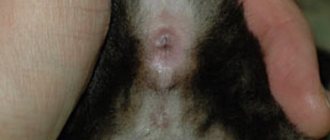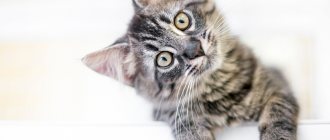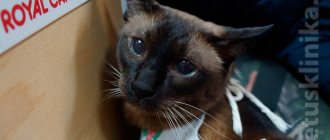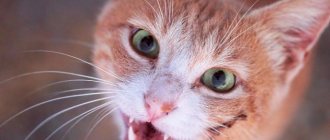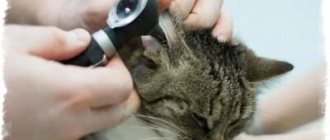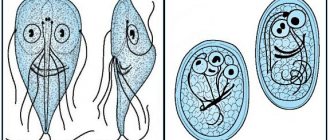Pulmonary edema in cats is a serious pathology that is associated with the accumulation of fluid in the alveoli of the lungs, which complicates the process of gas exchange and causes oxygen starvation. Lack of oxygen for a long time leads to the death of brain cells, and suffocation can cause the death of the animal.
When the first signs of pulmonary edema appear in a cat, you must urgently seek help from a veterinarian; the lack of timely treatment will lead to the painful death of your pet.
What is pulmonary edema
The lungs consist of two paired organs and inside have a large number of alveoli (cells). The process of breathing in animals, as in humans, occurs with the participation of alveoli - peculiar bubble formations in the lungs, intertwined with a network of blood vessels. Under normal conditions, the alveoli of the lungs during inhalation are filled with oxygen entering the blood, which then carries it to the brain, nourishes the heart and tissues. When you exhale, exhaust air containing carbon dioxide is released through the alveoli.
In pulmonary insufficiency (edema), for various reasons, transudate (edematous fluid) and the liquid part of the blood enter the alveoli - infiltration. A sharp decrease in the working volume of the lungs disrupts the breathing process and leads to progressive oxygen starvation of the body.
Description
The structure of a cat's lungs resembles a bunch of grapes, only the alveoli act as a bunch.
They absorb oxygen inhaled by the cat, and when they exhale they release processed carbon dioxide. This natural process can be disrupted due to damage to the blood vessels or due to their increased permeability. All this can also be contributed to by various diseases and external factors. The capillaries of the alveoli become overfilled with blood fluid, which finds no outlet and accumulates in the alveoli. It interferes with normal gas exchange, resulting in hypoxia (oxygen starvation). In addition to the alveoli, fluid can accumulate in the connective tissues of the lungs (interstitium).
It should be noted that pulmonary edema in cats develops very rapidly. First of all, damage occurs to the brain and central nervous system. To prevent or treat the disease, it is important to know the causes of pulmonary edema.
Causes
Pulmonary edema in cats develops as a result of various causes. But it is worth remembering that this pathology is not a disease. Pulmonary edema is a serious symptom and type of complication that occurs against the background of an underlying illness.
Pulmonary edema in cats is divided into two main types:
- cardiogenic pulmonary edema in cats;
- swelling not associated with diseases of the cardiovascular system.
Cardiogenic
Very often, the cause of pulmonary edema in cats lies in heart disease. Some destructive processes in the heart and blood vessels lead to a deterioration in the flow of blood and lymph, as a result of which fluids stagnate and begin to fill the lungs.
Lung tissue itself is very porous, and it is full of cells, which is why this organ suffers in the first place. Cardiogenic pulmonary edema in cats is characterized by a gradual filling of the alveoli with fluid, an increase in oxygen starvation of tissues, turning into asphyxia. In this case, in order to save the animal, resuscitation measures cannot be avoided.
Cardiogenic pulmonary edema in a cat occurs when:
- Hypertrophic cardiomyopathy.
- Chronic heart valve diseases.
- Heart defect.
- Heart failure.
- Arterial hypertension.
- Cardiosclerosis.
- Pulmonary embolism.
Heart disease can be congenital or acquired. Cats of artificially bred breeds suffer from similar ailments more often.
Non-cardiogenic
The cause of pulmonary edema can also lie in injuries, disorders in the body, infectious diseases, and others:
- Allergic reactions (including to anesthesia).
- Aspiration pneumonia.
- Injuries to internal organs as a result of falls from height.
- Electric shock.
- Choking (carbon smoke poisoning).
- Anemia.
- Heatstroke.
- Lung cancer.
- Laryngeal paralysis.
- Head injuries: bruise and concussion.
- Severe stress.
- Injuries to internal organs during sterilization/castration operations.
- Poisoning with poisons and chemicals.
- Bacterial blood infections.
- Pancreatitis.
- Prolonged seizures (epilepsy).
- Poisonous snake bites.
- Uremia is intoxication resulting from renal failure.
- Anorexia.
- Sepsis.
- Aspiration is the entry of vomit into the respiratory tract.
Many owners who love to overfeed their pets are unaware that obesity leads to heart disease. This, in turn, entails other problems, including swelling of the organs.
Forecast
In 9 out of 10 cases, the prognosis for thoracic hydrops is cautious or unfavorable. This is due to the fact that hydrothorax causes venous stagnation, impedes lymphatic drainage, and fills the pleural cavity with edematous fluid (transudate). Against the background of this condition, tissue gas exchange is disrupted. All this leads to dysfunction of the heart muscle, so death is possible.
The accumulation of edematous fluid (transudate) in the pleural area of a cat leads to displacement of lung volume. This causes a decrease in tidal volume, which causes shortness of breath and even respiratory failure. In this case, the cat experiences panic, is afraid to lie down and most often sits to make it easier to breathe.
In especially severe cases, the animal does not sleep. Not only does his breathing become difficult, but his general health also worsens. Panic attacks develop. Taking a horizontal position, cats in some cases cannot breathe. All this is reflected not only in her behavior, but also in the state of the entire organism.
If your cat exhibits symptoms of hydrothorax, contact a professional veterinarian immediately. This will increase your pet’s chances of recovery and ensure a quick recovery of his body!
Predisposition to disease
Pulmonary edema of a cardiogenic nature more often occurs in cats of certain breeds that have a hereditary tendency to cardiovascular pathologies. This breed defect is inherent in many artificially bred cat breeds:
- sphinxes;
- Maine Coon;
- the British;
- Scottish Fold;
- Persian and representatives of other breeds.
Kittens more often suffer from traumatic pulmonary edema. The pathology develops in them after chest injuries, to which they are very susceptible.
There is no difference in the incidence of this pathology between males and females.
Treatment of the disease
Treatment of pulmonary edema begins with resuscitation measures designed to support the cat’s life. First of all, this is oxygen therapy, which consists of forcing the cat to breathe through a special mask where oxygen is supplied or placing it in an oxygen chamber for a certain time.
If the cause of pulmonary insufficiency is a foreign body or vomit entering the respiratory tract (aspiration), then they are removed by tracheostomy (extending the trachea).
The main treatment consists of drug therapy:
- getting rid of swelling and excess fluid in tissues - diuretics, diuretics (Furosemide);
- normalization of heart function - drugs that relieve heart failure and affect tissue metabolism (Carboxylase);
- decreased pressure in the pulmonary circulation - ganglion blockers (Bromide, Trimetaphan);
- stimulation of breathing - drugs that stimulate the parts of the brain responsible for breathing (Sulfocamphocaine);
- relieving inflammation - antihistamines (Dexamethasone);
- If pulmonary edema occurs in a cat due to a bacterial infection, then treatment with antibiotics is started.
After the acute condition has been relieved, therapy for the underlying disease begins, during which medications of various types are used, according to indications, depending on the nature of the disease.
Treatment of pulmonary edema and associated diseases should only take place in a hospital, since the serious condition of the animal requires constant medical supervision.
Symptoms
If pulmonary edema occurs, it is important to contact a veterinary clinic as soon as possible. By what signs can owners suspect that their pet is developing such a life-threatening condition? With pulmonary edema, an insufficient amount of oxygen enters the body. The first symptoms you should pay attention to:
- the cat is breathing heavily;
- wheezing appears when breathing;
- shortness of breath is observed after slight physical activity;
- the animal spreads its paws wide, lowers its head and greedily swallows air, trying to catch its breath;
- in difficult situations, the cat lies on its side, its breathing is hoarse and strained;
- a cough appears in which wheezing, gurgling sounds are heard;
- Bloody foam may come from the nose and mouth, and the tongue may stick out.
In addition to respiratory symptoms, the following signs are observed:
- rapid, but weak, shallow heartbeat;
- pallor or cyanosis of the mucous membranes;
- a sharp decrease in temperature and pressure.
If you notice any similar symptoms, you should immediately contact a veterinary clinic. In some cases, edema of the lungs and other internal organs in cats progresses very quickly and there is a risk of losing your pet literally in a matter of days or even hours.
Symptoms of hydrothorax: how to recognize the disease in your pet?
The first thing you need to pay attention to is your pet’s behavior. With hydrothorax, shortness of breath gradually develops, the body temperature remains normal, but due to internal changes, the mucous membranes become bluish (cyanosis). When palpating the chest area, there is no pain, but there is swelling.
One of the features of hydrothorax is its stages. Periods of exacerbation may be followed by temporary relief. However, don’t mistake this for recovery! Remember that hydrothorax in cats requires professional veterinary treatment.
Signs of hydrothorax (dropsy) in cats:
- general weakness,
- fast fatiguability,
- increasing shortness of breath,
- appetite disorders,
- cyanosis of the mucous membranes (pressure restores the natural color),
- swelling in the perineum, chest, eye area and paws.
A cat suffering from dropsy loses the desire to play. She spends more time in solitude, has virtually no contact with people, and does not go into arms. With hydrothorax, animals lie down with their paws widely spread forward and their heads stretched upward. Breathing becomes heavier (long inhalation and short exhalation).
Diagnostic methods
If you suspect fluid accumulation in your pet's lungs, you should immediately contact a veterinarian and do not self-medicate or let the situation take its course.
Diagnosis of pulmonary edema requires an integrated approach, which includes the following measures:
- Chest X-ray.
- Echocardiography - ultrasound of the heart.
- Listening with a stethoscope.
- Analysis of urine.
- General blood analysis.
- Blood test for biochemistry.
The test results are processed by a specialist to determine the root cause of the swelling.
Important! The diagnosis of pulmonary edema cannot be made solely on the basis of anamnesis and examination of the pet - remember this when choosing a clinic and attending physician.
Diagnosis of the disease
The first step in treating hydrothorax is diagnosis. The veterinarian needs to confirm the diagnosis, determine the cause of the disease and make a prognosis. To do this, a clinical examination is carried out, an anamnesis is collected (the cat's owner is interviewed) and additional diagnostic methods are used for greater accuracy.
At the discretion of the veterinarian, the following is prescribed:
- radiographic examination,
- thoracentesis with fluid analysis,
- blood test (clinical/biochemical),
- scatological research, etc.
Based on the diagnostic data obtained, the veterinarian develops a treatment plan for hydrothorax in the cat.
Treatment
The treatment regimen will depend entirely on the diagnosis. If a disease is detected that causes fluid accumulation in the tissues, treatment is directed specifically at its elimination. But whatever the disease, therapy is primarily aimed at eliminating severe symptoms and reducing fluid in the cat’s lungs.
First aid before going to the veterinary clinic
If there are signs of pulmonary edema, immediate assistance to the animal is very important, since it determines whether resuscitation will be successful. Before delivering the cat to the clinic, it is necessary to make the breathing process as easy as possible for her using improvised methods:
- inject a diuretic (Furosemide) if available;
- open the windows or take the cat out into the fresh air;
- provide the animal with complete rest and limit physical activity;
- do not disturb or take any forceful action towards him;
- deliver to the clinic as quickly as possible;
- During transportation, it is advisable to place the animal on its side.
If first aid is provided correctly, then subject to a professional approach to the choice of treatment method, there is hope that the animal will recover.
Activities in the hospital
To relieve pulmonary edema, the “patient” is given an intramuscular injection (Dexamethasone, Hydrocortisone, Prednisolone, Diprospan). Each of these drugs has an effective anti-edematous effect and helps to avoid acute hypoxia.
To compensate for the lack of oxygen in the cat’s body, the doctor can put it in a pressure chamber or put an oxygen mask on its face.
The “fluffy dog” is also given (orally or by injection) a diuretic drug to remove excess fluid, if the drug was not administered by the owner before visiting the clinic.
In severe cases, when the animal is near death, artificial ventilation or intubation is performed.
Just like people, when they are sick in an unfamiliar environment, cats experience a lot of stress. To calm the “mustachioed” one, he is given sedatives.
If all of the above methods do not help, surgical methods are used to remove fluid from the lungs.
Treatment of thoracic hydrops in cats
Treatment of hydrothorax in cats is based on an integrated approach. It is necessary to eliminate the cause of the disease, as well as its symptoms. The cat needs to be provided with complete peace and comfortable conditions. It is necessary to completely exclude liquid food from the diet and reduce the consumption of water, milk and other liquids.
You need to feed your pet often, but in small portions. The diet should be balanced; if necessary, the veterinarian will give dietary recommendations.
If chest dropsy is caused by an infectious disease, then treatment is aimed at combating its causative agent. If a parasitic infection is detected, deworming is carried out in the clinic against parasites. If the disease was provoked by cachexia (depletion of the body), then a therapeutic diet, vitamin intake and supportive therapy are provided.
At the same time, symptomatic treatment is prescribed. The first thing the veterinarian does is remove the accumulated edematous fluid (transudate) using a puncture of the pleural cavity. Then, to restore the function of the heart muscle and reduce the load on it, heart medications are prescribed.
At the discretion of the doctor, maintenance therapy may include not only diet and vitamin therapy, but also infusion therapy. The dropper contains glucose and a calcium chloride solution. They ensure rapid recovery of the body of an animal exhausted due to a serious illness. Additionally, diuretics are prescribed.
What are the dangers of self-medication of pulmonary edema?
Some people are interested in whether it is possible to cure pulmonary edema in a cat on your own? Under no circumstances should you do this. Firstly, special medications and injections are required to quickly relieve swelling and replenish oxygen in the animal’s body. Secondly, as mentioned above, edema is not an independent disease, but only a consequence of another pathology. And it’s not enough just to eliminate the swelling, you need to find the cause and try to cure it.
At home, a cat can be given first aid, but it is still necessary to take it to a specialist for examination. Even if you manage to remove fluid from the cat’s respiratory system on your own and relieve pulmonary edema, a relapse risks reoccurring with even more serious consequences.
Diagnosis of the disease
Diagnostic procedures should be as prompt as possible, since suffocation can progress rapidly. Sometimes it is advisable to start treatment procedures in parallel with diagnostics, so as not to miss time. Basic diagnostic measures:
- A detailed survey of the owner about the behavior and well-being of the animal since the moment of illness.
- External examination and auscultation (listening) of the lungs and heart.
- X-ray examination of the chest. Based on the pulmonary pattern, one can determine the nature of the pathology, since areas of the lungs that do not take part in the breathing process and the level of fluid in the alveoli are visible. Pathological changes in the heart muscle are also determined. X-rays also help to carry out differential diagnosis, which makes it possible to separate the disease from other pathologies of the heart and respiratory system.
- Ultrasound of the heart is prescribed if a cardiogenic origin of the disease is suspected, to determine how much the contractility of the left ventricle is altered.
- An electrocardiogram provides information about the presence of ventricular hypertrophy, arrhythmias and ischemia of the heart muscle.
- A general and biochemical blood test will complement the picture of the disease with a number of clinical signs.
Prevention
There are no special preventive measures to protect against pulmonary edema. Prevention consists of careful monitoring of animals that are at risk for cardiovascular and colds:
- Regularly undergo preventive examinations with mandatory vaccinations.
- Prevent the risk of allergic reactions.
- When purchasing food, be guided not by price, but by quality.
- Do not restrict the cat's movements. The more she runs and plays, the better for her health.
- Avoid contact with electricity and toxic substances.
- Avoid hypothermia and overheating.
- Do not let the animal outside unattended.
The main rule is simple - constant monitoring of the cat’s condition. This is especially true for owners of purebred cats. You need to pay more attention to your pets, and they will be healthy.
Pulmonary edema in cats is treatable provided that the animal is constantly monitored and timely contact a specialist if the slightest signs of the disease are detected. Relapses occur mainly in cats with heart disease or due to age. You should carefully monitor your pets to prevent a recurrence.
Prevention of hydrothorax
Prevention of thoracic hydrops in cats is aimed at preventing factors that can lead to this disease (mechanical injuries, exhaustion of the body, infectious and parasitic diseases). Pay attention to several useful recommendations that, in some cases, will help avoid the development of hydrothorax in cats:
- Vaccinate your pets against infectious diseases in a timely manner at the veterinary clinic. It is important to consider which infections often affect animals in the region where you live.
- Carry out antiparasitic treatment (deworming) 1-2 times a year. This applies not only to those cats that have the opportunity to go outside, but also to pets.
- Always consult a veterinarian for diseases of the cardiovascular system, kidneys and liver. This will avoid the possibility of developing thoracic hydrops in cats as a concomitant condition with the disease.
- Pay attention to your pet's diet . It must be healthy and balanced. To provide additional prevention of hydrothorax, try to fortify it with vitamins C and K.
Remember that the main thing with chest dropsy is to promptly seek help from a veterinarian!

